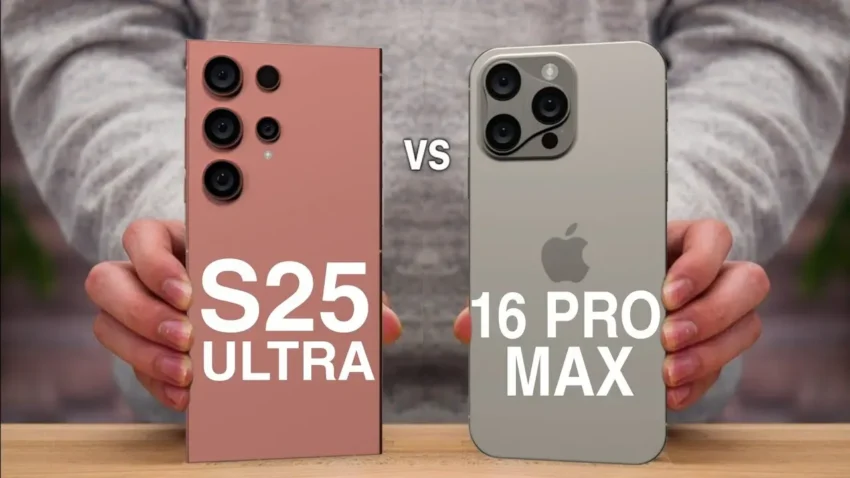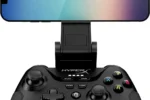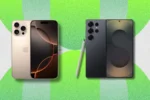In the rapidly evolving world of thin smartphones, the upcoming Samsung Galaxy S25 Edge vs. iPhone 17 Air is set to be a significant showdown in 2025 smartphone trends. Both Samsung and Apple are gearing up to redefine sleekness and performance in their latest devices, promising to captivate tech enthusiasts and casual users alike. The Samsung Galaxy S25 Edge, with its rumored ultra-slim profile, aims to challenge the anticipated design of the iPhone 17 Air, which is shrouded in mystery yet equally poised to impress. As we delve into this smartphone comparison, we will explore how these two titans plan to balance aesthetics with cutting-edge technology, offering features that cater to the demands of modern users. Stay tuned as we uncover the details that will set these models apart in the competitive landscape of 2025.
As we anticipate the arrival of the latest flagship models, a thrilling competition is brewing between two of the most renowned brands in the tech industry. The sleek Samsung Galaxy S25 Edge and the enigmatic iPhone 17 Air promise to showcase the pinnacle of innovation in the realm of lightweight and stylish devices. With the trend towards thinner smartphones gaining momentum, both manufacturers are poised to leverage cutting-edge technology to deliver exceptional user experiences. From their design philosophies to the features embedded within, this smartphone comparison will highlight how each device is tailored to meet the evolving needs of consumers. Join us as we explore the exciting developments that await in the battle of these slim marvels.
2025 Smartphone Trends: The Rise of Thin Devices
As we step into 2025, the smartphone market is witnessing a significant shift towards thinner devices, a trend that both Samsung and Apple are keen to capitalize on. The anticipated releases of the Samsung Galaxy S25 Edge and the iPhone 17 Air are prime examples of this evolution, where manufacturers are not just focusing on performance but also on sleek, lightweight designs. The demand for thin smartphones is fueled by consumer preferences for portability and aesthetics, which are becoming as critical as technical specifications. This year, we expect to see innovations that allow for more compact designs without sacrificing battery life or performance.
The trend towards slim smartphones is complemented by advancements in materials and technology that make it possible to create high-performing devices in a lightweight format. For instance, innovations in battery technology are allowing for smaller, yet more efficient power sources, which is essential for maintaining battery life in such slender profiles. Additionally, display technology is advancing, enabling manufacturers to fit larger screens into smaller chassis, enhancing user experience while keeping the devices remarkably thin.
Samsung Galaxy S25 Edge vs. iPhone 17 Air: A Clash of Thin Titans
The upcoming competition between the Samsung Galaxy S25 Edge and the iPhone 17 Air is generating significant buzz, particularly due to their focus on thinness. Both devices are rumored to be at the forefront of 2025 smartphone trends, showcasing how far manufacturers have come in terms of design and engineering. The Galaxy S25 Edge is expected to sport a sleek profile, rumored to be as thin as 5.6mm, while the iPhone 17 Air could potentially be even thinner at around 5.5mm, making this a head-to-head match in the thin smartphone category.
This face-off between the Galaxy S25 Edge and iPhone 17 Air not only highlights the race for thinner devices but also emphasizes the importance of design aesthetics in consumer choice. As both Samsung and Apple gear up to unveil their slim models, potential buyers are eager to see how each brand will integrate cutting-edge technology into their designs. The Samsung Galaxy S25 Edge aims to deliver a robust camera experience despite its slender form, while the iPhone 17 Air is expected to leverage Apple’s signature integration of hardware and software to enhance user functionality.
Design Features: Comparing Slimness and Aesthetics
When it comes to design, the Samsung Galaxy S25 Edge and the iPhone 17 Air are set to impress with their striking aesthetics and ultra-slim profiles. Samsung’s design philosophy typically emphasizes a premium feel, and the S25 Edge is expected to follow suit with high-quality materials and a sleek, modern look. Reports indicate that the device may feature a minimalistic design that complements its thinness, likely incorporating curved edges that not only enhance grip but also provide a visually stunning appearance.
On the other hand, Apple’s iPhone 17 Air is anticipated to embody the company’s signature sleekness, possibly adopting a design language that echoes previous models while introducing new elements to appeal to modern consumers. The iPhone 17 Air’s thinner profile could allow for a more refined and elegant appearance, appealing to users who prioritize aesthetics alongside functionality. As both devices strive for a premium look, the competition in design will be as fierce as it is in performance.
Camera Capabilities: Thin Phones, Big Expectations
In the realm of photography, both the Samsung Galaxy S25 Edge and iPhone 17 Air are expected to challenge the notion that thin smartphones can’t deliver high-quality images. The Galaxy S25 Edge is rumored to feature a powerful 200MP main camera, a significant upgrade that could redefine mobile photography standards. With such a high megapixel count, users can expect exceptional detail and clarity in their photos, even when cropping, which is crucial given the device’s compact design.
Conversely, the iPhone 17 Air may take a different approach by focusing on a single 48MP camera that emphasizes software optimization to achieve impressive results. Apple’s strength has always been in its computational photography, and the iPhone 17 Air will likely leverage advanced algorithms to enhance image quality. Despite its thin profile, Apple aims to provide a camera experience that meets the expectations of its users, proving that even a slim design does not mean compromising on photography capabilities.
Performance Insights: Power in a Slim Package
The performance of the Samsung Galaxy S25 Edge and iPhone 17 Air is a crucial aspect that consumers will be keenly observing. With the Galaxy S25 family expected to utilize Snapdragon 8 Elite chipsets, the S25 Edge is anticipated to deliver top-tier performance. However, the challenge of maintaining cooling efficiency in such a thin design may lead Samsung to consider alternative options, which could affect the overall performance capabilities of the device.
Meanwhile, Apple is likely to equip the iPhone 17 Air with its next-generation A19 chip, promising enhanced performance and energy efficiency. Given that Apple has a reputation for optimizing its hardware and software to work seamlessly, users can expect smooth performance from the iPhone 17 Air, even with its slimmer design. The ability to deliver high performance in a compact form factor will be a key differentiator for both devices in the competitive smartphone market.
Battery Life: Efficiency Meets Slimness
Battery life is always a concern with thin smartphones, and the Samsung Galaxy S25 Edge and iPhone 17 Air will need to address this challenge creatively. With limited space for larger batteries, both manufacturers are likely to focus on optimizing their devices to maximize battery efficiency. The Galaxy S25 Edge is rumored to feature 25W wired charging, which, although not the fastest available, could provide sufficient power for daily use given the device’s expected performance.
For the iPhone 17 Air, Apple’s emphasis on energy efficiency with its A19 chip could mean that users will experience a more extended battery life despite the smaller form factor. Apple has a history of integrating software optimizations that enhance battery performance, so the iPhone 17 Air could very well set a standard for longevity in thin devices. As consumers increasingly demand more from their smartphones, effective battery management will be a crucial selling point for both the Galaxy S25 Edge and iPhone 17 Air.
Software Features: The Role of AI in Thin Smartphones
As we move towards a more connected world, artificial intelligence is becoming a focal point for new smartphone releases, particularly in thin models like the Galaxy S25 Edge and iPhone 17 Air. Samsung is expected to introduce advanced AI features with the S25 series, which may also be integrated into the S25 Edge. These features could include enhanced camera capabilities, voice recognition, and smart multitasking options that leverage AI to provide a seamless user experience.
On the other hand, Apple is likely to enhance its existing AI functionalities within the iPhone 17 Air, ensuring that it remains competitive in this area. With the anticipated iOS 19 update, users can expect new AI-powered features that could significantly enhance usability. The integration of AI in both devices aims to provide smarter, more intuitive interactions, making the thin design not just about aesthetics but also about improving overall user experience.
Market Outlook: Predictions for Consumer Preferences
The forthcoming releases of the Samsung Galaxy S25 Edge and iPhone 17 Air are poised to reshape consumer expectations in the smartphone market. As these devices emphasize thinness, consumers will need to weigh the pros and cons of these new models against traditional smartphones. While slim profiles are appealing, users will also consider factors such as performance, camera capabilities, and battery life when making purchasing decisions.
Moreover, the competition between Samsung and Apple is expected to drive innovation, pushing both companies to enhance their offerings continually. As 2025 unfolds, it will be interesting to observe how consumer preferences evolve, particularly regarding the balance between design and functionality. The Galaxy S25 Edge and iPhone 17 Air will likely set benchmarks for future smartphone designs, influencing trends in the industry for years to come.
Frequently Asked Questions
What are the key differences in design between the Samsung Galaxy S25 Edge and iPhone 17 Air?
The Samsung Galaxy S25 Edge is rumored to be as thin as 5.6mm, potentially making it one of the slimmest smartphones alongside the iPhone 17 Air, which might reach a thickness of 5.5mm. Both devices aim for a sleek design, with the Galaxy S25 Edge potentially featuring a 6.7-inch display compared to the 6.6-inch display of the iPhone 17 Air.
When is the expected release date for the Samsung Galaxy S25 Edge and iPhone 17 Air?
The Samsung Galaxy S25 Edge is rumored for a summer 2025 release, possibly in June, while the iPhone 17 Air is expected to launch in September 2025, aligning with Apple’s typical fall announcement schedule for new iPhones.
How do the camera specifications compare between the Samsung Galaxy S25 Edge and iPhone 17 Air?
The Samsung Galaxy S25 Edge is expected to feature a dual-camera setup with a 200MP main camera, while the iPhone 17 Air is rumored to have a single 48MP camera. This difference highlights Samsung’s focus on advanced camera technology in their thin smartphone.
What performance features can we expect from the Samsung Galaxy S25 Edge and iPhone 17 Air?
Both smartphones are anticipated to utilize advanced chipsets, with the Galaxy S25 Edge possibly using the Exynos 2400 for efficiency due to its thin design, while the iPhone 17 Air is expected to feature Apple’s latest A19 chip, enhancing overall performance and battery efficiency.
What battery life and charging capabilities are expected for the Samsung Galaxy S25 Edge compared to the iPhone 17 Air?
The Samsung Galaxy S25 Edge is rumored to support 25W wired charging, while specific details for the iPhone 17 Air’s charging capabilities are not yet available. Both devices may rely on efficient chipsets to maximize battery life given their slim designs.
Will the Samsung Galaxy S25 Edge and iPhone 17 Air support the latest AI features?
Yes, both the Samsung Galaxy S25 Edge and iPhone 17 Air are expected to integrate advanced AI capabilities, with Samsung incorporating new Galaxy AI features and Apple likely enhancing its iPhone 17 Air with upcoming AI tools from the iOS 19 update.
What is the expected pricing for the Samsung Galaxy S25 Edge and iPhone 17 Air?
Pricing rumors suggest that the Samsung Galaxy S25 Edge may range from $649 to around $1,299, depending on its positioning in the lineup, while the iPhone 17 Air might start at approximately $899, potentially replacing the iPhone 16 Plus.
How do the display technologies compare between the Samsung Galaxy S25 Edge and iPhone 17 Air?
The Samsung Galaxy S25 Edge is expected to feature a 6.7-inch AMOLED display, while the iPhone 17 Air is rumored to have a slightly smaller 6.6-inch display. Both are anticipated to offer high-quality visual experiences in their thin smartphone designs.
What are the anticipated software features for the Samsung Galaxy S25 Edge and iPhone 17 Air?
The Samsung Galaxy S25 Edge is expected to include the latest Galaxy AI features and enhancements from the S25 series, while the iPhone 17 Air will likely support existing Apple Intelligence features and improvements from the upcoming iOS 19.
Which smartphone is likely to offer better camera versatility, the Samsung Galaxy S25 Edge or iPhone 17 Air?
The Samsung Galaxy S25 Edge is expected to offer greater camera versatility with a dual-camera system and a high megapixel count, while the iPhone 17 Air may focus on a single camera setup, limiting its optical capabilities.
| Feature | Samsung Galaxy S25 Edge | iPhone 17 Air |
|---|---|---|
| Release Date | Expected around Summer 2025, possibly June or April | Expected in Fall 2025, likely September |
| Pricing | Rumored to be between $649 and $1,299 depending on model | Likely to start around $899, could go higher than $1,199 |
| Design Thickness | Rumored to be around 5.6mm to 6.4mm | Analysts suggest it could be as thin as 5.5mm, but likely around 6.6mm |
| Display Size | Expected 6.7 inches | Expected 6.6 inches |
| Camera | Rumored to feature a 200MP main camera | Likely to have a single 48MP camera with 2x zoom capability |
| Performance Chipset | Possibly Exynos 2400 due to thin design limitations | Expected to use A19 chip, built on a 3nm process |
| Battery & Charging | Expected 25W wired charging | Battery life critical, details not yet available |
| Software & AI Features | Expected to include new Galaxy AI features | Expected to include Apple Intelligence and iOS 19 features |
Summary
The Samsung Galaxy S25 Edge vs. iPhone 17 Air comparison reveals two highly anticipated smartphones that will redefine thinness in 2025. Both devices are set to showcase advanced technology, including powerful cameras and AI features, while maintaining a sleek design. As we await more details, these upcoming models promise to deliver innovative experiences to consumers eager for the next generation of smartphones.






